#should do it more often its a great exercise for shapes
Explore tagged Tumblr posts
Text
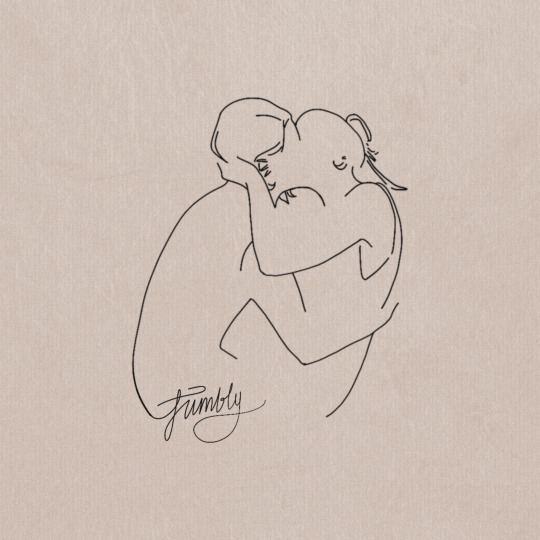


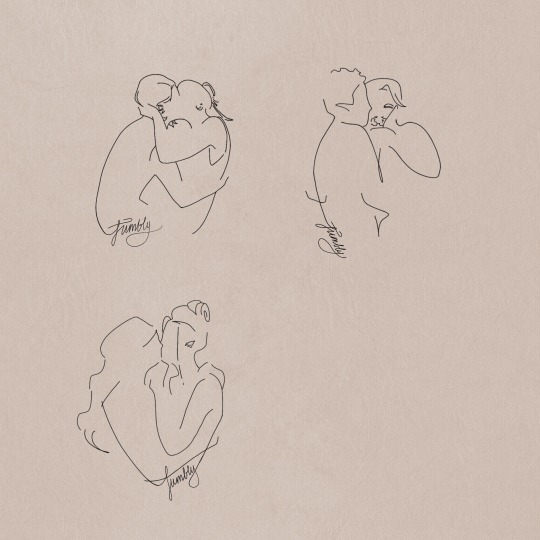
Tried my hand at some line art! My favorite CR ships kissing <3
Bonus with no specific ship in mind under cut

#critical role#imaudna#shadowgast#beauyasha#imogen temult#laudna#essek thelyss#caleb widogast#beauregard lionett#yasha nydoorin#critrole fanart#tumblysart#my brain wanted to draw but my body says rest#so i just opened pinterest#looked for couples kissing photos#and started outlining their shapes#that was fun!#should do it more often its a great exercise for shapes#and when trying to draw specific characters its fun deciding and outlining their moat recognisable features#done in procreate btw
169 notes
·
View notes
Text
NAKED SNOW WALKING AND THE BIRCH MOON
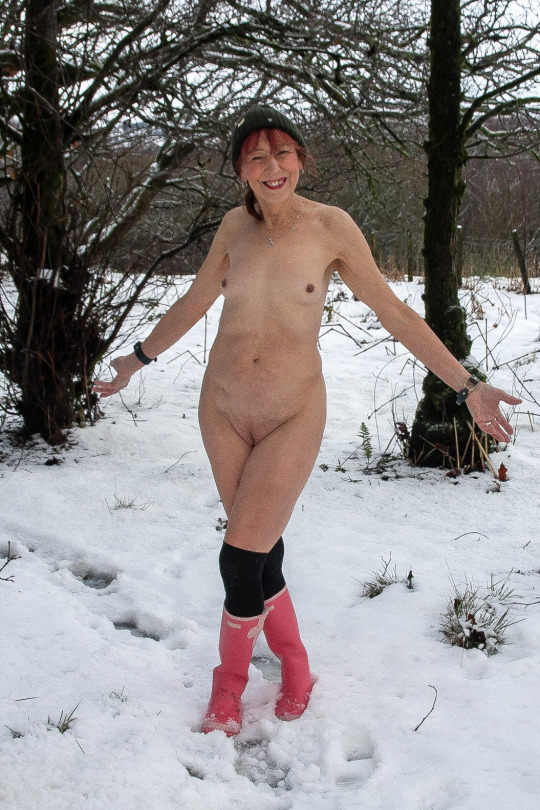
The first new moon after the Winter Solstice has various names. Some call it the Ice Moon, others the Snow Moon. Here in the High Pennines the snow has been plentiful and deep. The weather feels exceptionally icy. Here in the Britain however it is rarely ever far below freezing. We have a mild climate compared to say, Continental Europe or the Northern States. It's a great time for naturism!
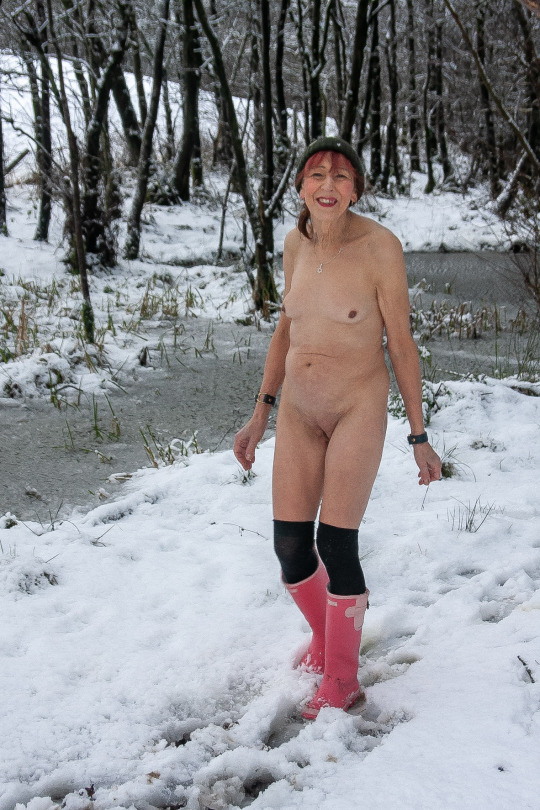
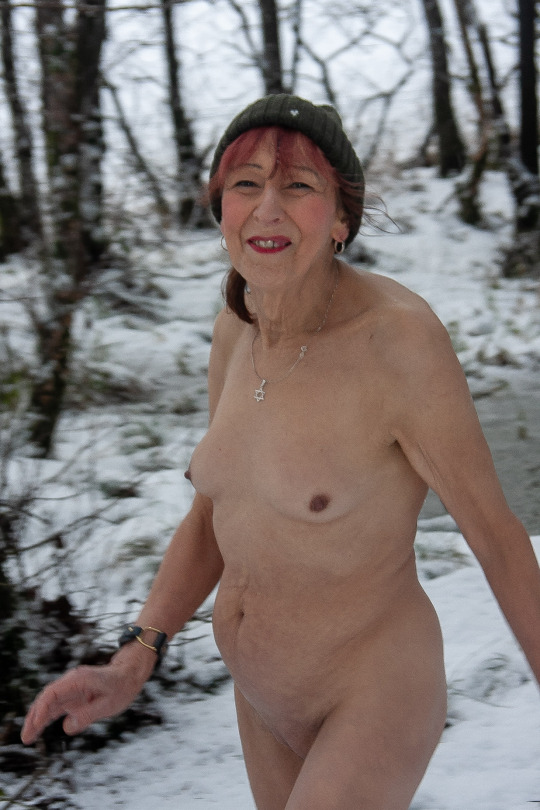
We headed up to the Wild Wood on January 6th. It was an invigorating walk, uphill. We walked briskly, we had to! Walking clothes free when it is this cold is a very different experience to textile walking. In the depths of Winter, people tend to layer and muffle up. True, all those clothes DO keep you warm when sedentary; layers trap body heat. However, as you exercise, particularly when walking briskly, things are very different. Muffled up in layers, you rapidly slow down as you overheat, carrying the burden of heavy clothing. Naked, you walk briskly, unencumbered by the weight of clothes. You don't want to stop or slow down and your naked body soon acclimatises to the cold. Stepping out and climbing the hill to the wood felt refreshing, invigorating and ever so free!

The wild, wooded hills around here were once heavily mined for coal and yellow clay to make bricks. The industry left its scars for a while, even after it had gone. Nature will always reassert itself and soon, woodland returned. The countryside began to recover. One of the first trees to regenerate is birch. The Wild Wood has older trees, mainly oak, but around it's fringes, birch and alder predominate. On snowy days like this, the silvery bark of birch shines like a beacon. It isn't a long lived tree. The soil is thin and rocky here. Birch often succumbs to the ravages of winter storms. Birch has a more human life span than other trees; 80 would be a good age for a mature specimen. This tree is nonetheless a hardwood and has long been used for all manner of beneficial things.
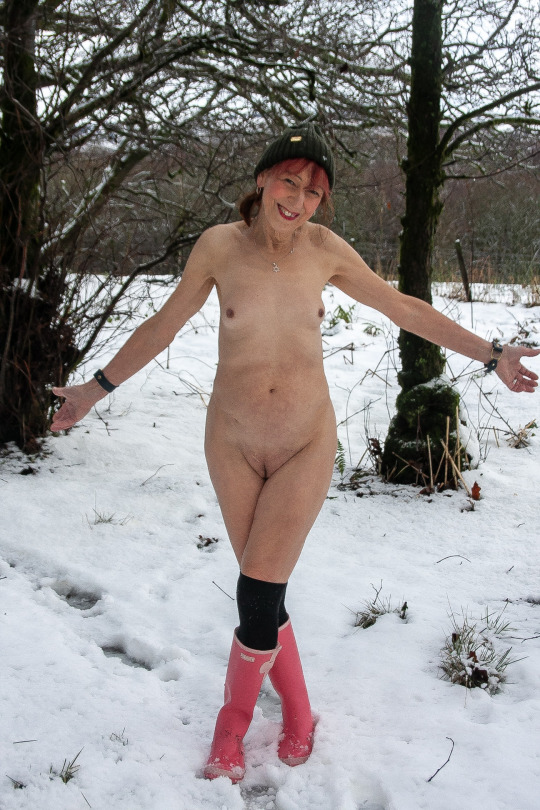
Birch, being the first tree to grow back after devastation, has a connection to birth and new life. Baby's cradles were made from birch wood and the tree is deeply associated with fertility, renewal and re-birth. Birch twigs make good broomsticks, perfect for a clean sweep of your house at the start of the year. Cattle were herded with a bunch of birch twigs which was also thought to ensure fertility. When birch grows again in Spring, its delicate pale green leaves are heart shaped. The sap of the birch tree is also used to make a delightful wine. Britain's Queen Victoria was said to have been very fond of it!
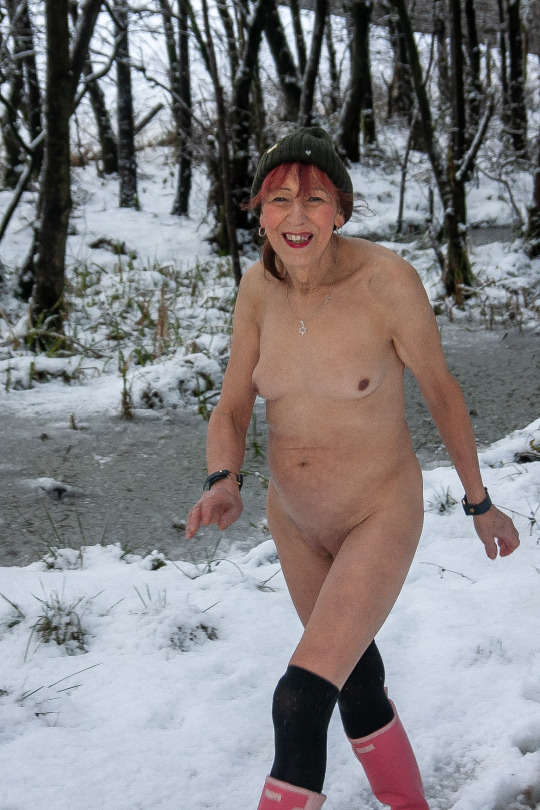
We made our way to the very summit of the Wild Wood. Here, the woodland is denser and criss-crossed by little paths. Holly shines green and glossy amid the larger trees. There are also larch, oak, ash and sycamore. Out on the sheep pasture beyond, sheep were scraping at the snow, searching for grass. We walked the wood but saw nobody. There was only one other set of prints on the previous night's snow. We stopped to take the photographs which we have shared in this blog. Thank you to Mart, my loving husband for these. He adores naturism every bit as much as me.

The ground temperature was low and I was glad of my pink wellingtons with two layers of socks. My green wool beanie (thank you sheep) was a must; most of the heat you lose is from your head. We hope you find our photographs inspiring.

It would be lovely to see other's photographs of their own naked snow hikes. We look forward to seeing your posts. Tumblr has way too many endlessly recycled photos of naked young women on summer beaches! Give it a rest. The promotion of naturism needs contemporary photos of yourselves, enjoying your local environment as nature intended. why not write as well, describing what you do. Non-sexual nudity should, and does represent, all manner of body shapes and types. You are never too old to walk naked. You were born this way.


We receive lots of messages of affirmation from likeminded naturists. Thank you so much. I also receive some flattering yet less suitable comments and requests from others who are; how shall I put it? - not exactly passionate about naturism, more about sexy naked ladies! Let's face it, who isn't? Sex is great and I love it. It isn't however the focus of this blog.
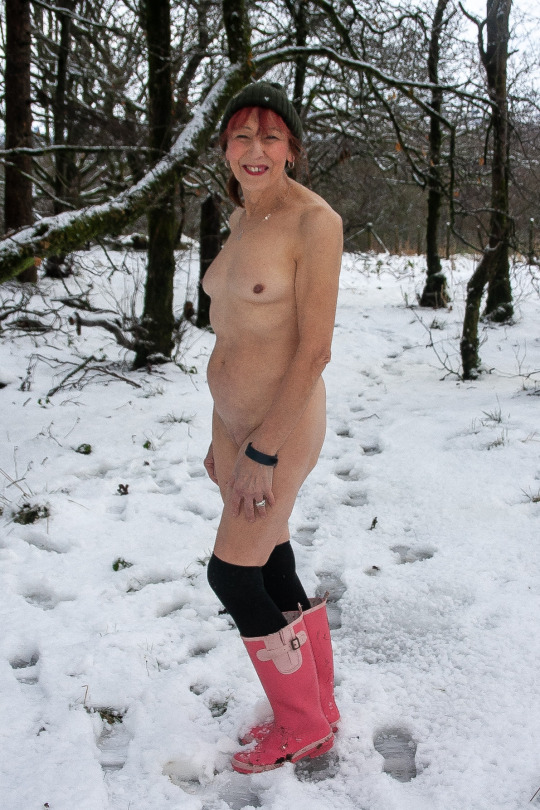

My purpose in writing this, is to inspire you to your own naturist activities. So while it is gratifying to have you send photos of one tiny part of yourself, please don't. Most of these messages come from Tumblrs who follow hundreds of others yet are entirely empty with no avatars. Sadly, I have come to realise that these accounts are best blocked, no offence. We do welcome messages of support however as well as photographs of your own naturist jaunts and hikes. So if you want to follow me and have me follow back, post an avatar which is actually you and some real pictures of yourself in your blog. Message and tell me what motivates you to naturism! OK?
Stay naked!
Jane xx
#naturist#nude outdoors#clothesfree#nude in nature#normalize nudity#girlblogging#outdoor nudity#hiking#woodland walk#winternaturism#winter#naked hiking#naked in the woods#naked in nature#nonsexual nudity
89 notes
·
View notes
Text
Codex: Stronger Where it Breaks
Pairing: Non-binary!Lavellan x Solas Characters: Solas (Fen'Harel), Non-binary/Non-Inquisitor Lavellan Fandom: Dragon Age: The Veilguard Rating: G Warnings: Mental Health Discussion Other Tags: DA4 Spoilers, Post-Veilguard, Fake Codex Entries Read here on AO3.
An unsigned note found within a well-tended corner of the Fade, written in an experienced hand, yet one that bears the trappings of a self-taught writer. The handwriting changes subtly with each line, as though the writer had to return to the project over a long period.
Ian has suggested that I take some time to reflect upon more than my regrets, and record what I cherish.
I will not argue— even should I have wished to, I would find myself at a disadvantage. He has always been more stubborn than he cares to admit, and the years have made him moreso. Instead, I will mind his wisdom, as time has taught me that it often outpaces my own.
Putting paint to canvas and notes to a tune; reminding myself that creation is always within my grasp.
The next line is obscured by a sharp scratch, though its impression has not been struck out entirely.
The look upon [illegible]’s face when [illegible] Elgar’nan rhymes with [illegible].
It has proven difficult, although perhaps not more than anticipated. Regret is a disease, as contagious as the blight we seek to soothe. Even that which I cherished is riddled with its infection, and I do not know if a day will come where I do not see its spectre over me. Ian is more encouraging. It is a beginning, he says. He reminded me of when we first met, when I recounted passing moments witnessed in the lives of strangers as though I were reciting a great, heroic tale. Remember them when I reflect upon my own life, and begin with small steps.
He likened it to a muscle in a newly healed leg: atrophied and at times stumbling in its step, but in need of exercise.
How like him it is to speak of this in surgeon’s terms.
May you learn— an old curse, a cruel curse. Yet there is an older saying, a prayer, or perhaps in this godless age I ought to call it a hope: may I learn. Not every lesson is easily imparted, but I do not begrudge them as I did.
Labouring over a puzzle for the better part of an afternoon. Satisfaction at its completion.
There is gold in the sky. A passing sheaf, but not lessened for its finiteness.
My favourite tune. He knows it by heart, now.
The words stop abruptly, the following pages contain sketches for what appear to be murals, drawn in the style of ancient Elvhenan. While the words before were hesitant, the pictures flow with a more certain hand, the words before lending conviction.
One bears the figure of an elf holding a paintbrush kneeling before a mostly empty page; the tilt of their head is reverent, as if in awe at the limitless potential before them. Another, a beating heart behind a thin body made up of roots. The next is a complex looking puzzle turned between a pair of hands.
The final page is a picture of a Dalish elf with thin, leafless branches, broken at the brow by a sun-shaped scar. Behind him, there are scenes of grief and loss— flaming swords bearing down upon a Circle; a woman with a tree-shaped crown; an Archdemon upon a black tower; a broken arrow— but the figure in the foreground eclipses them all, a neverending future blooms in the palms of his hands.
A final line follows:
Being here, with him by my side.
#my writing#da4 spoilers#solian#solavellan#solas#nb!solavellan#bi solas#iander lavellan#joly and i are still discussing where ian's story will go compared to canon but. regardless. i love them.#i made myself sad writing this bc it was hard thinking of stuff in his life that hasnt been touched by regret ghsdkfj im SO
28 notes
·
View notes
Note
Hi, I was wondering if you have resources or examples of what system mapping is/looks like? My therapist mentioned it and I don't really understand what that ... looks like. And also can't find any real resources on it
System mapping refers to a lot of record keeping, more so than most people think of when they hear about it. The most common route for this exercise is a visual aid, often done on blank printer paper or with a computer application that allows for shapes with text in them.
Some goals for system mapping can be seeing how system members
are related (who knows who, how they interact with one another, how they define their connections)
came into the system (who split from who, when they showed up, what happened to get them)
fit into the collective (who’s similar or different, how roles make sense, where triggers chain together)
exist in space (how close to one another they are, where things are in the internal world, how visualized barriers come into play)
are themselves (which labels they use, which things they like and dislike, how they exist as one being and a member of a group)
Here are some examples of maps for each of these things





I did these taking only a few minutes each, and they’re simplified versions of real maps we’ve done in the past. Maps should be thought-provoking, a dumped box of ideas you connect on the page. Sometimes it takes hours (or days, but that’s usually an avoidance problem).
We’re working on one right now that shows when different color codes came into play for us. Our system is huge, so this is a broader project that doesn’t address individual members or subgroups. We took a poster paper and some colorful pens, made some notes at the top, and are drawing a garden with a central tree and some flowers for pieces that don’t make sense as a branching out. We worked on it several hours straight, redid it twice, and it’s still not done.
Our largest system map is a wall of post-its hanging on for dear life, with different color notes and ink for different purposes. We have a whole legend of symbols and would probably be using pins and yarn if we had a cork board. That one is everything; people and places, subgroups and relationships, programming and trauma, all of it.
If you(&)’re looking for resources, I have like two links I know I can find right now. Mostly this is a community topic, and you can watch people make maps on video sites like YouTube or TikTok. You’re less likely to find academic material about system mapping unless you’re looking for discussion about treatment or plain case studies, and I dislike contextualizing the exercise like they do.
I like the first link because they’re creative with it, which is great for visual aids. They also remind you that mapping isn’t for everymany/body, and that it’s okay not to do it or not include everyone.
The second isn’t specific to mapping, but has a bullet list I liked from another site that was more commercial.
A third one I thought about including but didn’t had some good reasons for mapping for integration (helping each other notice they’re connected, that there are reasons the system works like it does), but was more clinical.
Actually, I feel bad explaining it and not showing it, so you(&) choose if that sounds okay to you.
There are many larger articles which include aspects of system mapping, but reading them requires a lot of sifting and determining what is real to you(&) before you can make use of most of what’s written. It can help form opinions, and it will also send some cascading. If you look into the academic side, remember to look into the community side, too. You need both, just maybe not as early as mapping the system for the first time.
Poster paper is system mapping. Sand trays are system mapping. Roll calls are system mapping. Community meetings are system mapping. System mapping is getting to know your(&) system. You can’t really do it wrong, but I hope you got some ideas of where to start.
14 notes
·
View notes
Text
habits you should have, regardless of beauty standards:
we all know that sex sells, and if youre like me, you refuse to be a part of it. the issue is, many of the habits that are advertized to be for the improvement of your looks, are actually really important for your health as well, often times even life saving. if youre like me, you might be unaware of this and deliberately NOT participating in them as a protest against beauty standarts, which might actually be hurting you. let me tell you which! (long post)
1. wearing sunscreen:
unless you have a lot of melanin, you should wear sunscreen every time the uv index is 3 or higher, to protect yourself from skin cancer.
why does society tell us to wear it?
i always hear 'sun exposure gives you wrinkles, freckles, sunspots, etcetc' and went 'well i dont CARE, fuck you' and never wore it.
everybody tries to sell sunscreen as 'antiaging'. its crazy how thats the biggest selling point, and not the fact that sunscreen protects you from getting CANCER.
heres the thing, you SHOULDNT care about getting wrinkles! theres nothing wrong with them, no matter how 'premature' they are!
why you should actually wear it:
you should care about skin cancer though. asides from melanoma, which has very low survival rates, other skin cancers, while not as deadly, can then spread to different organs and *cause* other deadly cancers.
okay, im new to sunscreens, what should i do?
well first, let me say that mineral vs chemical doesnt really matter, as long as the spf is high enough. the general rule is the higher the spf, the better.
if i were to reccomend a sunscreen, it would be beauty of joseon. it has gone viral, and while i do think its overhyped, i think its a great basic. its pretty cost efficient, not sticky or smelly and doesnt burn my eyes.
you should apply spf if the uv index is 3 or higher, which you can check the levels in your area on any weather website. if youre staying outside for longer than 2 hours, you should reapply.
you dont have to wear suncreen indoors! your windos block most uv rays.
your face needs at least a quarter of a teaspoon to be fully protected. of course the amount varies depending on the size of your face, but usually two fingers are enough to protect your face:

to save as much sunscreen as possible, try to stay in the shade and and cover your body when going outdoors!
before you go to sleep, you should remove your spf by double cleansing!
2. working out:
why does society tell us to work out?
the most common answer is: to lose weight. the get a 'desirable' body shape. to get a 'healthy' body shape.
there are many scientific papers that talk in depth about how your weight isnt indicative of your health, so i am going to spare you, and i certainly dont need to go in depth about how nobody should conform to societys beauty standards.
another thing worth pointing out is that often times, exercise cannot actually give you the shape you want. there are many factors to this, such as genetics or hormones, but the fact is, exercise often just wont help you archieve the ideal body shape anyway.
why should you actually work out, then?
many reasons!
-being in shape (metaphorically, not literally) will make moving around easier and you'll get less tired perfoming your daily tasks.
-working out improves mood and helps with brain fog
-increases energy levels (ironically)
-good for cardiovascular health, digestive health, good for bone heath: that means that as you age, you are more likely to retain more of your mobility than if you didnt work out, and your body will in general be happier
-sometimes it helps you socialize, participate in community etc.
how to get into working out?
now, this is the fun part: there is no wrong way to go about this!
you dont need to do a specific type of working out! in fact, just pick whatever suits you!
you can run or go for walks. dance in your living room or attend dance class. shadow box. go to the gym to box.
lift weights or do at home calisthenics, do chloe ting workout videos, climb trees, go for a bike ride, whatever!
just keep moving! you should workout a few times a week :) you dont need any fancy equipment or clothes.
3. eat healthy
now, this one may be different definition of a healthy diet than youve heard of: you shouldnt eat less, but more. the biggest adjustment to your diet shouldnt be removing things but adding things.
you should eat a lot of vegetables, as well as proteins, sugar and fats.
you can keep your fries and a burgers, but you should add a salad as well!
maybe you grew up believing that you dont like healthy things, like fish or collard greens, but you might be living in a lie :D
i reccommend trying new recipes, you might be surprised!
a good diet will have similiar effects to working out- its very important to nourish your body so that it can work properly.
5 notes
·
View notes
Text
My body issues are acting up again, so naturally I project them on to a fictional character - because I can't, for the love of god, find a therapist. This is mainly a sad Hob/caring Dream self indulgence.
I'm thinking about Hob falling into a rabbit hole on the internet and not being his happy confident self. Maybe it's because things move on so fast this century. Maybe it's because you're connected with everything all the time.
The thing is Hob used to think very little about his body. First because he just had to keep it running, later he focused on achieving different things from money to education.
Bodies and their shapes however, seem to be the main focus of people these days. So it's for the first time that he actually looks at himself and worries. He is quite on the hairy side of men and since he quit the soldering he got quite soft around the middle. After his experience with starvation, he enjoyed food more than ever and perhaps, indulged more than it was appropriate.
Since Dream visited more often and things were evolving from friendship to relationship, Hob feels more and more insecure. Dream used to persue great leaders and goddesses. Hob is neither and it bothers him. He fears that he won't be able to keep Dreams attention for long. So maybe being nice to look at would help him. Just to keep him a little longer.
The plan of action is quite simple. Lose the fat and gain more muscle mass. The internet offers a lot of solutions. From healthy to harmful - he can't die, so what does it matter? He cuts back on food, fits regular exercise in his already busy schedule and soon sees results. His body changes but his insecurities don't. He still finds things to dislike or right on hate about himself. It affects his whole life, his mood and his dreams.
Right after Dream told him about his true nature, Hob asked him to not interfere with his dreams. He liked them - dreams and nightmares alike. Just like he loved life with its ups and downs.
Now he suffers through nightmares of not fitting into his clothes, people calling him nasty things, Dream leaving him for someone better looking.
Dream of course notices the changes but doesn't know how to bring them up. While he honours his promise, he can't help to steal a glance at Hobs visits in the Dreaming. He just needs to understand what's happening. When he does it breaks is heart. It really does. He still doesn't know how to confront his friend, who became way more than a friend, during his past visits.
Falling in love with Hob had been so easy and felt so natural, it had never occurred to Dream, that it needed clarification.
His next visit is, like all visits, unannounced but carefully planed. He enters into Hobs living room and finds him standing in front of a huge mirror. Just staring at his reflection without really seeing anything. Dreams stands behind Hob and startles him. When Hob tries to turn around Dream just shakes his head and holds on to Hobs hips. They are way sharper than they should be. Pointy bones easily felt trough the fabric of his trousers. Slowly Dream moves closer and presses himself into Hobs back, finding his gaze in the mirror.
They've rarely been this close and Dream cherishes the warmth that's oozing from Hob.
"Dream..wh- what are you doing?" Hob stutters. Heat filling up his cheeks and the tips of his ears. He feels caught and ashamed and so happy to have Dream touch him.
"I worry." Dream answers, his voice a deep hum. "You seem to be unaware of how much you mean to me. Meant to me through all the centuries. It seems that I have neglected to show you." He sounds remorseful.
"Dream.." Hob starts but Dreams look shuts him up.
"Please, Hob, let me finish. I want you to know. I need you to know, that you are acknowledged and seen. That you are loved and cherished. I need you to know that my feelings for you run deep and will not fade. I need you to know that you are in my thoughts permanently and that I wouldn't change that, even if I could. It hurts me to see you hurt so deeply, Hob Gadling, as your wounds feel like my own." During his speech a wet sheen covers his eyes and tears cling on long lashes. Hob tries to take a deep breath but it gets caught in his throat and turns into a wet sob. Big tears run down his face and his emotions are all over the place and drowning him.
Carefully Dream steps around himself and blocks his view into the mirror. Hob feels Dreams arms hold him close in a loving embrace and between one blink and the next, they are in his bedroom, no mirrors in sight. He is guided onto his bed and held through all his sobs, tears and sniffles. Fingers carding through is hair and rubbing circles on his back. "I'm sorry" he whispers again and again. "You have nothing to apologize for, my love".
The endearment rips another sob from Hob. He feels utterly pathetic. But Dream is patient and holds him. When the sobs stop, he tells him stories and when he falls asleep, he is welcomed in the Dreaming with warm hands and gentle kisses.
Nothing changes over night. Hob is still painfully insecure and worries whenever Dreams been kept away for a longer period of time. Dream is patient and kind and doesn't tire of showing his love for Hob in all the ways he knows.
#dreamling#dream of the endless#hob gadling#the sandman#i want somebody to get the cuddles I need#self indulgence at its finest#sad hob
29 notes
·
View notes
Text
rodents-for-sale
Rodents make excellent pets for people looking for a low-maintenance and affordable companion. Whether you're a first-time pet owner or an experienced enthusiast, rodents can provide fun and companionship without the need for extensive care. There are a wide variety of rodents for sale, each with its own unique personality, care needs, and lifespan. If you're considering adopting a rodent, here’s a guide to some of the most popular rodents for sale and the essentials of their care.
1. Hamsters
Hamsters are among the most popular and beloved rodent pets due to their small size, low-maintenance care, and playful nature. They are ideal for people with limited space, such as those living in apartments.
Popular Hamster Species:
Syrian Hamsters: Known for their larger size and friendly, solitary nature. They’re easy to handle and are often the go-to choice for pet owners.
Dwarf Hamsters: Smaller in size, dwarf hamsters can live in pairs (if introduced properly). They are very active and love to explore.
Roborovski Hamsters: The smallest of the dwarf hamsters, Roborovskis are fast-moving and a bit more challenging to handle due to their quickness.
Care Tips:
Cage Setup: Hamsters need a secure, spacious cage with a wheel for exercise, tunnels, and bedding for burrowing.
Diet: They require a mix of hamster pellets, fresh vegetables, and occasional fruits. Avoid sugary treats, as they can lead to health issues.
Lifespan: Typically live 2 to 3 years.
2. Gerbils
Gerbils are social, curious, and active rodents that are relatively easy to care for. They are often recommended for younger pet owners due to their playful nature and ease of handling.
Care Tips:
Cage Setup: Gerbils need a large tank with plenty of bedding for burrowing. A solid-floor cage is recommended to prevent injury to their feet.
Diet: Gerbils enjoy a diet of gerbil pellets, fresh vegetables, and occasional fruits. They also enjoy seeds and grains.
Lifespan: Gerbils typically live 3 to 4 years.
3. Guinea Pigs
Guinea pigs are one of the most popular rodent pets due to their gentle temperament and social nature. They are larger than hamsters and gerbils, making them great pets for children and adults alike.
Popular Guinea Pig Breeds:
American Guinea Pig: Known for their smooth, short coat and friendly nature.
Abyssinian Guinea Pig: Recognized for their distinctive, rosette-shaped fur.
Peruvian Guinea Pig: These guinea pigs have long, silky fur and are highly social.
Care Tips:
Cage Setup: Guinea pigs need a large, well-ventilated cage with plenty of bedding. They also need access to hay and fresh water at all times.
Diet: Guinea pigs require a diet of hay, pellets, and fresh vegetables, particularly leafy greens. They need vitamin C supplements as they cannot produce it on their own.
Social Animals: Guinea pigs are social and do best in pairs or groups.
Lifespan: Guinea pigs typically live 4 to 6 years, though some can live longer with proper care.
4. Rats
Rats are highly intelligent and social rodents that are often underappreciated as pets. They can form strong bonds with their owners and are known for their playful, affectionate behavior. Rats are also easy to train, and many can be taught to perform tricks or respond to commands.
Care Tips:
Cage Setup: Rats require a spacious, well-ventilated cage with multiple levels, ramps, and enrichment items like toys or tunnels to explore.
Diet: A balanced rat food mix along with fresh fruits, vegetables, and occasional protein will keep your pet healthy.
Social Animals: Rats thrive when kept in pairs or small groups. They are highly social and should not be kept alone for extended periods.
Lifespan: Rats generally live 2 to 3 years.
5. Mice
Mice are small, easy to care for, and very active. While they may not have the same level of social interaction as guinea pigs or rats, they can still be fun and entertaining pets to watch.
Care Tips:
Cage Setup: Mice require a small cage with a wheel for exercise, bedding for nesting, and plenty of space to explore.
Diet: Mice eat a variety of foods, including small amounts of fruit, vegetables, and specially formulated mouse pellets.
Lifespan: Mice typically live 1 to 2 years.
6. Chinchillas
Chinchillas are known for their extremely soft, dense fur and their playful, curious nature. While they require a little more attention and care than other rodents, they can be incredibly rewarding pets.
Care Tips:
Cage Setup: Chinchillas need a large cage with plenty of room to jump, climb, and explore. They require special dust baths to clean their fur, as they cannot bathe in water.
Diet: Chinchillas require a high-fiber diet, primarily consisting of hay and pellets. They also need fresh water and occasional treats like dried fruits.
Exercise: They are very active and need daily playtime outside their cage.
Lifespan: Chinchillas can live up to 10 to 20 years with proper care.
7. Degus
Degus are small, diurnal rodents that are often compared to guinea pigs and chinchillas. They are social animals that enjoy interacting with their owners and other degus.
Care Tips:
Cage Setup: Degus need a large cage with horizontal bars for climbing, along with bedding for nesting and tunnels for exploration.
Diet: Degus are herbivores and require a diet rich in fiber. Their diet should mainly consist of hay and specially formulated pellets.
Social Animals: Degus should be kept in pairs or small groups for companionship.
Lifespan: Degus live 5 to 9 years.
Things to Consider Before Buying a Rodent
When purchasing a rodent, it’s important to consider the following:
Research: Each rodent species has different care requirements. Be sure to research the specific needs of the rodent you are interested in before making a purchase.
Space: Rodents like guinea pigs and chinchillas need larger cages with plenty of space for exercise and exploration, while hamsters and mice require smaller setups.
Time Commitment: Some rodents, such as guinea pigs and rats, require more social interaction and care than others.
Laws and Regulations: Make sure to check your local laws regarding the ownership of exotic or non-native rodents. Some areas may have restrictions on certain species.
Veterinary Care: Ensure that you have access to a veterinarian who specializes in small animals and can provide appropriate care if your pet gets sick.
Where to Find Rodents for Sale
If you’re looking to purchase a rodent, websites like animalssale.com may have listings for various rodent species. It’s important to ensure that the animals come from reputable breeders or rescue organizations that prioritize animal welfare.
If you decide to buy from a breeder, look for one who provides healthy, well-socialized animals and follows ethical breeding practices. Alternatively, consider adopting from a local animal shelter or rescue organization, where you can find rodents in need of loving homes.
Conclusion
Rodents can make wonderful pets, providing companionship and entertainment with relatively low maintenance. From hamsters and guinea pigs to rats and chinchillas, each species offers unique characteristics that can suit different types of owners. Be sure to thoroughly research the care requirements of the rodent you’re interested in, and consider adopting from shelters or reputable breeders to ensure the health and well-being of your new pet.
0 notes
Text
rodents-for-sale
Rodents make excellent pets for people looking for a low-maintenance and affordable companion. Whether you're a first-time pet owner or an experienced enthusiast, rodents can provide fun and companionship without the need for extensive care. There are a wide variety of rodents for sale, each with its own unique personality, care needs, and lifespan. If you're considering adopting a rodent, here’s a guide to some of the most popular rodents for sale and the essentials of their care.
1. Hamsters
Hamsters are among the most popular and beloved rodent pets due to their small size, low-maintenance care, and playful nature. They are ideal for people with limited space, such as those living in apartments.
Popular Hamster Species:
Syrian Hamsters: Known for their larger size and friendly, solitary nature. They’re easy to handle and are often the go-to choice for pet owners.
Dwarf Hamsters: Smaller in size, dwarf hamsters can live in pairs (if introduced properly). They are very active and love to explore.
Roborovski Hamsters: The smallest of the dwarf hamsters, Roborovskis are fast-moving and a bit more challenging to handle due to their quickness.
Care Tips:
Cage Setup: Hamsters need a secure, spacious cage with a wheel for exercise, tunnels, and bedding for burrowing.
Diet: They require a mix of hamster pellets, fresh vegetables, and occasional fruits. Avoid sugary treats, as they can lead to health issues.
Lifespan: Typically live 2 to 3 years.
2. Gerbils
Gerbils are social, curious, and active rodents that are relatively easy to care for. They are often recommended for younger pet owners due to their playful nature and ease of handling.
Care Tips:
Cage Setup: Gerbils need a large tank with plenty of bedding for burrowing. A solid-floor cage is recommended to prevent injury to their feet.
Diet: Gerbils enjoy a diet of gerbil pellets, fresh vegetables, and occasional fruits. They also enjoy seeds and grains.
Lifespan: Gerbils typically live 3 to 4 years.
3. Guinea Pigs
Guinea pigs are one of the most popular rodent pets due to their gentle temperament and social nature. They are larger than hamsters and gerbils, making them great pets for children and adults alike.
Popular Guinea Pig Breeds:
American Guinea Pig: Known for their smooth, short coat and friendly nature.
Abyssinian Guinea Pig: Recognized for their distinctive, rosette-shaped fur.
Peruvian Guinea Pig: These guinea pigs have long, silky fur and are highly social.
Care Tips:
Cage Setup: Guinea pigs need a large, well-ventilated cage with plenty of bedding. They also need access to hay and fresh water at all times.
Diet: Guinea pigs require a diet of hay, pellets, and fresh vegetables, particularly leafy greens. They need vitamin C supplements as they cannot produce it on their own.
Social Animals: Guinea pigs are social and do best in pairs or groups.
Lifespan: Guinea pigs typically live 4 to 6 years, though some can live longer with proper care.
4. Rats
Rats are highly intelligent and social rodents that are often underappreciated as pets. They can form strong bonds with their owners and are known for their playful, affectionate behavior. Rats are also easy to train, and many can be taught to perform tricks or respond to commands.
Care Tips:
Cage Setup: Rats require a spacious, well-ventilated cage with multiple levels, ramps, and enrichment items like toys or tunnels to explore.
Diet: A balanced rat food mix along with fresh fruits, vegetables, and occasional protein will keep your pet healthy.
Social Animals: Rats thrive when kept in pairs or small groups. They are highly social and should not be kept alone for extended periods.
Lifespan: Rats generally live 2 to 3 years.
5. Mice
Mice are small, easy to care for, and very active. While they may not have the same level of social interaction as guinea pigs or rats, they can still be fun and entertaining pets to watch.
Care Tips:
Cage Setup: Mice require a small cage with a wheel for exercise, bedding for nesting, and plenty of space to explore.
Diet: Mice eat a variety of foods, including small amounts of fruit, vegetables, and specially formulated mouse pellets.
Lifespan: Mice typically live 1 to 2 years.
6. Chinchillas
Chinchillas are known for their extremely soft, dense fur and their playful, curious nature. While they require a little more attention and care than other rodents, they can be incredibly rewarding pets.
Care Tips:
Cage Setup: Chinchillas need a large cage with plenty of room to jump, climb, and explore. They require special dust baths to clean their fur, as they cannot bathe in water.
Diet: Chinchillas require a high-fiber diet, primarily consisting of hay and pellets. They also need fresh water and occasional treats like dried fruits.
Exercise: They are very active and need daily playtime outside their cage.
Lifespan: Chinchillas can live up to 10 to 20 years with proper care.
7. Degus
Degus are small, diurnal rodents that are often compared to guinea pigs and chinchillas. They are social animals that enjoy interacting with their owners and other degus.
Care Tips:
Cage Setup: Degus need a large cage with horizontal bars for climbing, along with bedding for nesting and tunnels for exploration.
Diet: Degus are herbivores and require a diet rich in fiber. Their diet should mainly consist of hay and specially formulated pellets.
Social Animals: Degus should be kept in pairs or small groups for companionship.
Lifespan: Degus live 5 to 9 years.
Things to Consider Before Buying a Rodent
When purchasing a rodent, it’s important to consider the following:
Research: Each rodent species has different care requirements. Be sure to research the specific needs of the rodent you are interested in before making a purchase.
Space: Rodents like guinea pigs and chinchillas need larger cages with plenty of space for exercise and exploration, while hamsters and mice require smaller setups.
Time Commitment: Some rodents, such as guinea pigs and rats, require more social interaction and care than others.
Laws and Regulations: Make sure to check your local laws regarding the ownership of exotic or non-native rodents. Some areas may have restrictions on certain species.
Veterinary Care: Ensure that you have access to a veterinarian who specializes in small animals and can provide appropriate care if your pet gets sick.
Where to Find Rodents for Sale
If you’re looking to purchase a rodent, websites like animalssale.com may have listings for various rodent species. It’s important to ensure that the animals come from reputable breeders or rescue organizations that prioritize animal welfare.
If you decide to buy from a breeder, look for one who provides healthy, well-socialized animals and follows ethical breeding practices. Alternatively, consider adopting from a local animal shelter or rescue organization, where you can find rodents in need of loving homes.
Conclusion
Rodents can make wonderful pets, providing companionship and entertainment with relatively low maintenance. From hamsters and guinea pigs to rats and chinchillas, each species offers unique characteristics that can suit different types of owners. Be sure to thoroughly research the care requirements of the rodent you’re interested in, and consider adopting from shelters or reputable breeders to ensure the health and well-being of your new pet.
0 notes
Text
How to Choose the Best IAS Academy in Coimbatore for Your UPSC Preparation

Choosing the right IAS academy for UPSC preparation is a crucial decision that can shape your entire journey toward becoming a civil servant. With numerous options available, selecting the best IAS academy in Coimbatore can be a daunting task. In this blog, we’ll guide you through essential factors to consider when choosing an academy, helping you make an informed choice for your preparation.
1. Reputation and Track Record
The first thing to look for when selecting the best IAS academy in Coimbatore is its reputation. Reputed academies have a proven track record of producing successful UPSC candidates over the years. Research their past results and testimonials from alumni to gauge how well they’ve helped students achieve their goals.
Real-World Example:
One example is the XYZ Academy, which has consistently produced top ranks in the UPSC exams for the past decade. Their students often praise the academy for its structured approach and high-quality teaching methods.
2. Quality of Faculty
The expertise and experience of the faculty members at the academy play a vital role in your preparation. Choose an academy with qualified and experienced faculty who are not only experts in their respective fields but also understand the intricacies of the UPSC syllabus and exam pattern.
Tip:
Look for academies that have teachers who are former civil servants or subject matter experts. Their first-hand experience can offer invaluable insights into the exam process.
3. Course Structure and Material
A well-structured course with updated and comprehensive study materials is essential for a successful IAS preparation. Ensure that the academy you choose offers a syllabus that aligns with the latest UPSC exam patterns. The study material should cover all subjects in-depth and offer practical exercises to reinforce learning.
4. Personalized Mentorship and Support
UPSС preparation can be overwhelming, so personalized mentorship and ongoing support can make a huge difference in your preparation. The best IAS academy in Coimbatore should offer one-on-one mentoring sessions and regular doubt-solving classes to ensure that you don’t miss out on important topics.
5. Infrastructure and Facilities
The learning environment plays an important role in maintaining focus and motivation. Look for academies that offer modern classrooms, well-stocked libraries, and convenient learning resources like online lectures or recorded sessions. Additionally, check if they provide facilities like hostel accommodation and transportation for outstation students.
6. Mock Tests and Practice Sessions
Frequent practice is key to success in UPSC exams. Choose an academy that offers regular mock tests, time-bound practice sessions, and personalized feedback. This will help you evaluate your progress and pinpoint areas that need improvement.
Expert Quote:
Dr. Rajesh Kumar, an experienced UPSC coach, says, “Mock tests are one of the best ways to prepare for the real exam. They help students build stamina and improve time management skills, which are critical for the UPSC exam.”
7. Success Stories and Alumni Network
Success stories from past students can be a great indicator of an academy’s quality. A strong alumni network is also beneficial, as it provides ongoing support and guidance even after the course ends. Reach out to current students and alumni to learn more about their experiences with the academy.
8. Affordability and Value for Money
While choosing an IAS academy, consider your budget. However, don’t just go for the cheapest option. The best IAS academy in Coimbatore will offer a balance between cost and the quality of education. Consider the value you’re getting in terms of faculty, study material, infrastructure, and additional services.
Conclusion: Making the Right Choice
Choosing the best IAS academy in Coimbatore requires careful consideration of the factors discussed above. Do your research, talk to alumni, and evaluate your options based on your unique needs. By selecting an academy that offers expert guidance, comprehensive study materials, and personalized support, you can give yourself the best chance of success in your UPSC journey.
Call to Action:
Ready to start your UPSC preparation? Take the first step by visiting the best IAS academy in Coimbatore today and discover the programs designed to help you succeed in your civil services career!
0 notes
Text
Most Calm Dog Breeds: 10 Pups with Chill Vibes
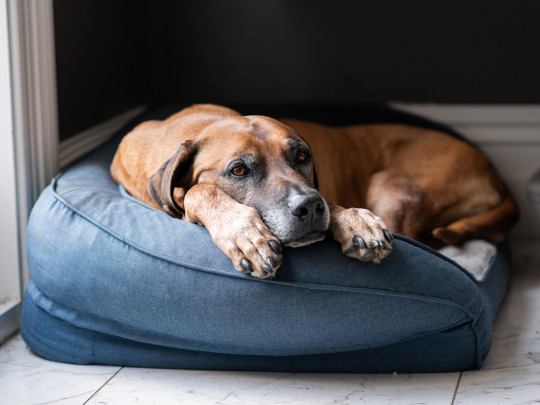
The energy level of the dog is definitely one of the most important things to consider if you’re thinking about adopting one. Dogs are often known for being lively and energetic creatures, but some would much rather kick back and watch TV with you than play fetch for hours on end. Calm temperaments are the result of many breeds being developed to do low-energy tasks, such guarding, entertaining, stealthily catching game, or simply being amiable.
tranquil dogs are tranquil dogs, but they still need frequent exercise to keep their bodies and minds in good working order. Even though they might not be prone to hyperactivity, they nevertheless require the chance to walk around, use up some energy, and breathe clean air.
Space is important, and not all dogs are good for apartment living, even though these easygoing canines will be happy to join you for a marathon viewing session. The same is true of size. Do you want to adopt a large dog, a medium-sized dog, or a little dog? Every size has less energetic dogs, especially if you think about adopting an older rescue dog who would just be content to live in a loving household. Your neighborhood shelter or rescue group is a great resource; their volunteers can serve as matchmakers to assist you select the ideal dog for your home. The following ten breeds are good options if you’re searching for a peaceful companion.
10 Super Chill Dogs
Senior Rescue Dog
Many senior rescue dogs are found in shelters; they are often seven years of age or older. Rescue dogs come in many shapes, sizes, and temperaments; some were once part of families but were given up. But compared to their younger counterparts, senior dogs tend to be calmer and slower-moving and simply want a secure place to call home throughout their golden years. They are usually already housebroken and need less training than younger canines. Senior dogs have a higher likelihood of some health concerns, such as arthritis or dental disorders, but they make up for it by being appreciative of their second shot at a good life.
Clumber Spaniel
Despite being bred primarily for bird hunting, Clumber Spaniels are often regarded as being more relaxed and tranquil than other spaniels. They are strangely cute because they have huge lumpy heads on shockingly short legs. They enjoy spending time together indoors and are quite affectionate. The Clumber requires frequent brushing due to its thick cream coat, which is often speckled with orange. They can also be more vulnerable to health conditions including hip dysplasia and vision impairments. To prevent weight gain, they should follow a balanced diet and engage in regular exercise. A respectable breeder should provide them, and you should keep up with their veterinary treatment.
Irish Wolfhound
Despite being transported to battlegrounds and taught to kill wolves, Irish Wolfhounds are more commonly referred to as “gentle giants” due to their extreme friendliness with children, adults, and other animals. Male Irish Wolfhounds can reach a height of 32 inches at the shoulder and weigh up to 120 pounds, making them one of the tallest breeds. Despite their massive stature, Irish Wolfhounds are incredibly calm and relaxed; they need regular exercise but are not very active. Walk them, make an impression on everyone you meet, and then bring them home for a lengthy snooze.
Pekingese
The Pekingese breed originated in the Chinese Imperial Court, where they were developed as companion dogs because they enjoyed company. This tiny breed is characterized by its long, opulent coat, flat face, and unusually floppy ears. Because of their love of people, these puppies make excellent pets for anybody looking for a low-energy canine that can live well in a small environment, while separation anxiety may become a problem if they are left alone for an extended period of time. Their lengthy coats wash the floor for free, but they also have some inherited health conditions that can make them expensive pets to maintain.
Greyhounds
Although they are recognized for their propensity for racing and hunting, greyhounds are actually among the most laid-back dog breeds; even if they are capable of energetic outbursts, they prefer to spend as much time as possible relaxing and sleeping. After their racing careers are done, many Greyhounds end up in rescues where they make wonderful family pets but poor security dogs since they are more likely to go back to sleep than to confront an intruder. For their health, they should take occasional walks and runs, but nothing compares to spending time with you on the couch. Additionally, these large dogs dislike stairs, so if you live in a house with stairs or a building without an elevator, take caution.
Leonberger
German breeds like the strong Leonberger are frequently used as herding and draft dogs. However, their calm disposition and high degree of trainability make them excellent family pets and frequently result in their usage as therapy dogs. Because they are courageous, they are frequently trained as search and rescue dogs. Make sure you have space inside and time outside for your leonberger because they have a thick coat that develops around their body in a huge ruff and they need frequent exercise and training to prevent destructive behavior.
Keeshond
The Keeshond is a peaceful medium-sized breed from the Netherlands that resembles a huge raccoon that you can securely keep in your house. They have a silver-gray coat and characteristic black markings around their eyes. They enjoy barking and being close to you since they were originally designed to be watchdogs and companions. Keeshonds are easy trainable, having gentle temperament by nature, and moderate energy levels. Exercise and social interaction on a daily basis will keep children happy.
Japanese Chin
Despite their name, the Japanese Chin is a little toy breed that originated in China and arrived in Japan during the 16th century. This breed features a big head, huge, widely spaced eyes, a short, flat snout, and a gorgeous tail that ends in a smooth, silky coat. They are sweet, loving, and enjoy being caressed. These calm puppies are excellent lap dogs and, due to their tendency toward self-grooming and climbing, are sometimes compared to cats. Although they are not as intelligent as other cats, they are nevertheless quite trainable.
Xoloitzcuintli
Known for being a calm and peaceful friend, the Xoloitzcuintli is a little, hairless dog with a small tuft of hair on top (but occasionally they even skip that modest ornamentation). The Xolo often bonds with a single family member, but they can be sociable with anyone they feel at ease around. Though generally calm, Xolos enjoy frequent long walks and time spent outside. These dogs require fewer showers than most because they are hairless, and frequent bathing can strip canines of their natural skin oils, leading to a variety of problems. A monthly bath with an occasional rubdown with a warm cloth are recommended.
Tibetan Spaniel
Tiny Tibetan Spaniels are developed to be small protectors in Tibet. These puppies don’t need a lot of exercise and might have calm, loving attitudes. Although they are devoted to their family and will rapidly bond with them, they are typically rather receptive to new acquaintances. Their floppy ears tip forward to frame their adorable features, and they have large almond-shaped eyes set in silky coats in a variety of colors of brown. Although they have a reputation for being a little stubborn, which young dogs frequently do, they are trainable.
Learn More: specialpets.org
0 notes
Text
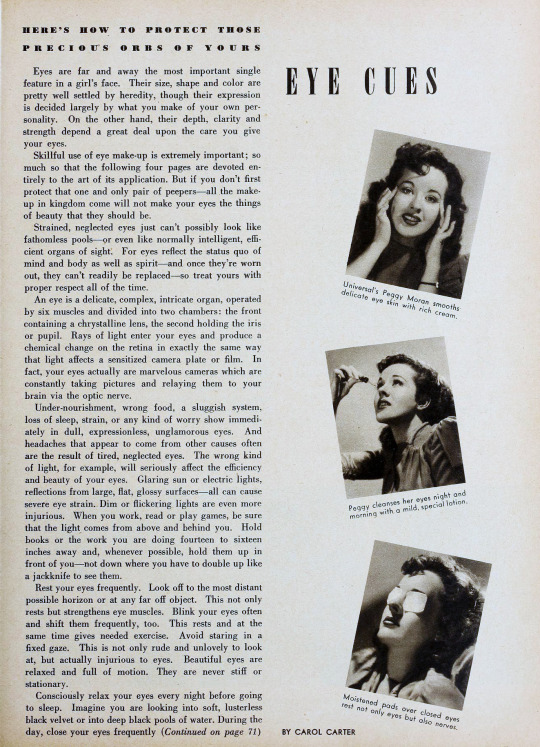
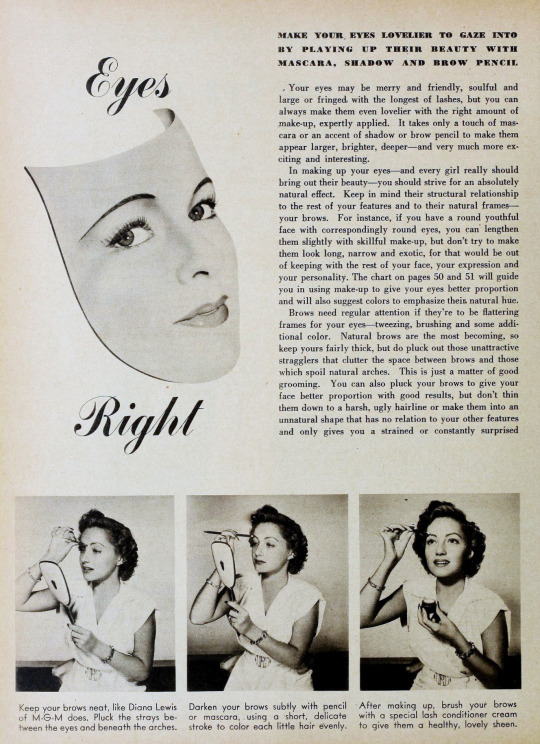
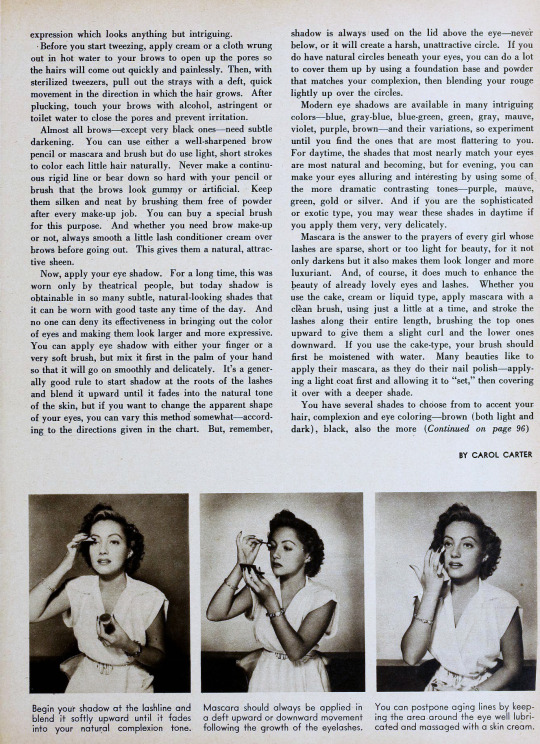


from Modern Screen, November 1941
EYE CUES BY CAROL CARTER
HERE'S HOW TO PROTECT THOSE PRECIOUS ORBS OF YOURS
Transcription Below!
Eyes are far and away the most important single feature in a girl's face. Their size, shape and color are pretty well settled by heredity, though their expression is decided largely by what you make of your own personality. On the other hand, their depth, clarity and strength depend a great deal upon the care you give your eyes.
Skillful use of eye make-up is extremely important; so much so that the following four pages are devoted entirely to the art of its application. But if you don't first protect that one and only pair of peepers—all the make-up in kingdom come will not make your eyes the things of beauty that they should be.
Strained, neglected eyes just can't possibly look like fathomless pools—or even like normally intelligent, efficient organs of sight. For eyes reflect the status quo of mind and body as well as spirit—and once they're worn out, they can't readily be replaced—so treat yours with proper respect all of the time.
An eye is a delicate, complex, intricate organ, operated by six muscles and divided into two chambers: the front containing a chrystalline lens, the second holding the iris or pupil. Rays of light enter your eyes and produce a chemical change on the retina in exactly the same way that light affects a sensitized camera plate or film. In fact, your eyes actually are marvelous cameras which are constantly taking pictures and relaying them to your brain via the optic nerve.
Under-nourishment, wrong food, a sluggish system, loss of sleep, strain, or any kind of worry show immediately in dull, expressionless, unglamorous eyes. And headaches that appear to come from other causes often are the result of tired, neglected eyes. The wrong kind of light, for example, will seriously affect the efficiency and beauty of your eyes. Glaring sun or electric lights, reflections from large, flat, glossy surfaces—all can cause severe eye strain. Dim or flickering lights are even more injurious. When you work, read or play games, be sure that the light comes from above and behind you. Hold books or the work you are doing fourteen to sixteen inches away and, whenever possible, hold them up in front of you—not down where you have to double up like a jackknife to see them.
Rest your eyes frequently. Look off to the most distant possible horizon or at any far off object. This not only rests but strengthens eye muscles. Blink your eyes often and shift them frequently, too. This rests and at the same time gives needed exercise. Avoid staring in a fixed gaze. This is not only rude and unlovely to look at, but actually injurious to eyes. Beautiful eyes are relaxed and full of motion. They are never stiff or stationary.
Consciously relax your eyes every night before going to sleep. Imagine you are looking into soft, lusterless black velvet or into deep black pools of water. During the day, close your eyes frequently if for only a second or two at a time. Relax them now and then by cupping your hands over each one to shut out all the light. After a hard day's work or before getting dressed for an extra-special date, wring out a square of cotton in ice cold skin freshener or a special eye lotion. Place one over each closed eye and relax for ten or fifteen minutes. Or use some of those handy little specially-prepared eye pads that come in jars ready for use. You'll feel rested and refreshed all over after using them. A rich emollient cream massaged with a rotary motion into all the delicate skin surrounding the eyes is another beauty trick which smoothes out wrinkles and relaxes tired nerves.
Of course, outdoor exercise, especially games which require your eyes to follow some small object like a golf, tennis or ping-pong ball is excellent for eyes.
Don't forget to eat for eye beauty also. Butter, cream, eggs, fresh vegetables and fruits are full of the essential Vitamin A.
Wear good, dark ground-lensed glasses when you must spend much time out in the glare of sun or snow or water. There are such good-looking dark glasses everywhere these days that they are as ornamental as they are beneficial.
EYES should be washed out night and morning with salt water, boric acid solution or one of the excellent specially prepared eye washes. These relax, stimulate and strengthen as well as cleanse out dirt and accumulated secretions.
Remember that the smaller the area on which you fix your gaze, the easier a time your eyes will have. Don't try to see everything at once. Focus your eyes on one object at a time, then move and shift them often. Roll your eyes to right and left, then all around slowly every time you have a few spare moments by yourself. Look up as far as you can, then down. Open your eyes wide, then close them tightly. Alternate these little exercises and repeat them frequently.
And if you ever find yourself with a foreign body—a speck of dirt, cinder, etc. —in one of your eyes, here are a few helpful tips to follow. First, do not rub it in. Hold both eyes wide open as far as possible, without blinking, until the tears begin to flow. If this won't work, take the small corner of a clean, dry kerchief or tissue and try to dislodge the offending object. Hold the lid away from your eyeball by grasping the lashes gently but firmly. Don't wrap your kerchief around any hard object such as a pencil, match or toothpick. You're likely to damage your eye permanently by just such a trick. If all these resources fail, hie yourself to the nearest drug store or doctor for more expert ministrations.
There—we've outlined the basic care to strengthen and protect those orbs of yours. Now you can safely concentrate on make-up. Follow the tips in "Eyes Right" and in the chart following. You'll go out and slay the stag line.
No eyes are truly lovely unless they are clear, bright and healthy-looking, so whenever yours feel tired and strained or are inflamed, soothe them with Eye-Gene lotion. You need just a drop in each eye and they appear clear and refreshed in seconds. Use it as frequently as you like, although twice a day is the usual routine. Eye-Gene is stainless so you don't need to worry about soiling hankies or clothes.
Photo captions:
Universal’s Peggy Moran smooths delicate eye skin with rich cream.
Peggy cleanses her eyes night and morning with a mild, special lotion.
Moistened pads over closed eyes rest not only eyes but also nerves.
---
Eyes Right BY CAROL CARTER
MAKE YOUR EYES LOVELIER TO GAZE INTO BY PLAYING UP THEIR BEAUTY WITH MASCARA, SHADOW AND BROW PENCIL
Your eyes may be merry and friendly, soulful and large or fringed with the longest of lashes, but you can always make them even lovelier with the right amount of make-up, expertly applied. It takes only a touch of mascara or an accent of shadow or brow pencil to make them appear larger, brighter, deeper—and very much more exciting and interesting.
In making up your eyes—and every girl really should bring out their beauty—you should strive for an absolutely natural effect. Keep in mind their structural relationship to the rest of your features and to their natural frames—your brows. For instance, if you have a round youthful face with correspondingly round eyes, you can lengthen them slightly with skillful make-up, but don't try to make them look long, narrow and exotic, for that would be out of keeping with the rest of your face, your expression and your personality. The chart on pages 50 and 51 will guide you in using make-up to give your eyes better proportion and will also suggest colors to emphasize their natural hue.
Brows need regular attention if they're to be flattering frames for your eyes—tweezing, brushing and some additional color. Natural brows are the most becoming, so keep yours fairly thick, but do pluck out those unattractive stragglers that clutter the space between brows and those which spoil natural arches. This is just a matter of good grooming. You can also pluck your brows to give your face better proportion with good results, but don't thin them down to a harsh, ugly hairline or make them into an unnatural shape that has no relation to your other features and only gives you a strained or constantly surprised expression which looks anything but intriguing.
Before you start tweezing, apply cream or a cloth wrung out in hot water to your brows to open up the pores so the hairs will come out quickly and painlessly. Then, with sterilized tweezers, pull out the strays with a deft, quick movement in the direction in which the hair grows. After plucking, touch your brows with alcohol, astringent or toilet water to close the pores and prevent irritation.
Almost all brows—except very black ones—need subtle darkening. You can use either a well-sharpened brow pencil or mascara and brush but do use light, short strokes to color each little hair naturally. Never make a continuous rigid line or bear down so hard with your pencil or brush that the brows look gummy or artificial. Keep them silken and neat by brushing them free of powder after every make-up job. You can buy a special brush for this purpose. And whether you need brow make-up or not, always smooth a little lash conditioner cream over brows before going out. This gives them a natural, attractive sheen.
Now, apply your eye shadow. For a long time, this was worn only by theatrical people, but today shadow is obtainable in so many subtle, natural-looking shades that it can be worn with good taste any time of the day. And no one can deny its effectiveness in bringing out the color of eyes and making them look larger and more expressive. You can apply eye shadow with either your finger or a very soft brush, but mix it first in the palm of your hand so that it will go on smoothly and delicately. It's a generally good rule to start shadow at the roots of the lashes and blend it upward until it fades into the natural tone of the skin, but if you want to change the apparent shape of your eyes, you can vary this method somewhat—according to the directions given in the chart. But, remember, shadow is always used on the lid above the eye—never below, or it will create a harsh, unattractive circle. If you do have natural circles beneath your eyes, you can do a lot to cover them up by using a foundation base and powder that matches your complexion, then blending your rouge lightly up over the circles.
Modern eye shadows are available in many intriguing colors—blue, gray-blue, blue-green, green, gray, mauve, violet, purple, brown—and their variations, so experiment until you find the ones that are most flattering to you. For daytime, the shades that most nearly match your eyes are most natural and becoming, but for evening, you can make your eyes alluring and interesting by using some of the more dramatic contrasting tones—purple, mauve, green, gold or silver. And if you are the sophisticated or exotic type, you may wear these shades in daytime if you apply them very, very delicately.
Mascara is the answer to the prayers of every girl whose lashes are sparse, short or too light for beauty, for it not only darkens but it also makes them look longer and more luxuriant. And, of course, it does much to enhance the beauty of already lovely eyes and lashes. Whether you use the cake, cream or liquid type, apply mascara with a clean brush, using just a little at a time, and stroke the lashes along their entire length, brushing the top ones upward to give them a slight curl and the lower ones downward. If you use the cake-type, your brush should first be moistened with water. Many beauties like to apply their mascara, as they do their nail polish—applying a light coat first and allowing it to "set," then covering it over with a deeper shade.
You have several shades to choose from to accent your hair, complexion and eye coloring—brown (both light and dark), black, also the more exotic blues and greens. The latter two are most suitable for evening make-up, but if applied with skill and if you are going to a festive function, you can get away with them at high noon. We wouldn't advise your wearing blue or green mascara with business or sport costumes, but they do look charming when a hat, veil, flowers and dressy clothes are worn. For formal occasions, some girls use two shades of mascara—tinting the lashes one color and the tips another. This takes a bit of extra skill but is strikingly effective.
Whatever shade of mascara you choose, be sure to keep your lashes looking always silken and natural. Brush them after applying mascara so that each is separate from the other, and brush them free of powder after every make-up job, too. Touching them with a little lash cream will not only keep them soft and healthy but will add a nice sparkle to your eyes.
If your lashes aren't the kind that curl of their own accord, use a curler to give them a flattering upturn that makes them look longer and your eyes bigger. The curl will stay in longer if you touch them with lash cream or apply mascara before using your curlers.
Make-up will make your eyes more beautiful, but if you want to keep them healthy, bright and youthful, be sure to follow common sense rules for care of your eyes. Crow's-feet and dry, shrivelled lids will detract from their beauty, so keep your eyes young and lineless by lubricating and massaging them regularly with a special cream. Every night before you retire, tap the cream gently around your eyes, using the pads of your fingers, working from the inner corners outward, above and below the eyes. Be careful never to pull or stretch the delicate tissue around the eyes in your massage routine.
Remember there are no eyes so lovely that they can't be enhanced by the subtle use of make-up, whether it's just a touch of mascara or an accent of shadow. Experiment with all the shades and kinds recommended for your type until you find the ones that suit you best. Then take plenty of time to apply them so as to look both natural and flattering. Your reward will be well worth the effort.
If you've always longed for lovely fringes of lashes, why not let Maybelline Cream Mascara make yours look longer, darker and more luxuriant. You'll find it the ideal consistency for easy applica-tion—neither too runny nor too thick—and it comes in three lovely shades—brown, black or blue—to accent your eyes and harmonize with your coloring. Maybelline Cream Mascara doesn't require water for application and comes in a handy purse-size tube, as it's easy to carry about for emergency make-up jobs.
You fastidious girls will be delighted with Djer-Kiss Lipstick. It comes in a new-type case which has a patent lock to keep the inner cylinder spic-and-span clean. Your fingers won't get smudged when you use it, and your purse will stay neat as you like. Djer-Kiss Lipstick is available in five radiant shades, from a warm natural to a daring brilliant red. It goes on smoothly and evenly, making your lips brighter and lovelier, and it lasts for hours.
Photo captions:
Keep your brows neat, like Diana Lewis of M-G-M does. Pluck the strays between the eyes and beneath the arches.
Darken your brows subtly with pencil or mascara, using a short, delicate stroke to color each little hair evenly.
After making up, brush your brows with a special lash conditioner cream to give them a healthy, lovely sheen.
Begin your shadow at the lashline and blend it softly upward until it fades into your natural complexion tone.
Mascara should always be applied in a deft upward or downward movement following the growth of the eyelashes
You can postpone aging lines by keeping the area around the eye well lubricated and massaged with a skin cream.
#1940s#1941#makeup#vintage inspiration#vintage beauty#vintage glamour#film magazine#fan magazine#modern screen
1 note
·
View note
Text
Interesting Facts About Fox Terrier Dogs
The Fox Terrier is a breed of dog that has its roots in the British Isles. It is known for being stubborn and having a lot of energy. This breed has a long history. It was first bred to hunt foxes, which is how it got its name. The Smooth Fox Terrier and the Wire Fox Terrier are the two types. Each has its own personality and charm. In this detailed guide, we'll talk about where the Fox Terrier came from, what it looks like in general, and how it rates on things like adaptability, friendliness, grooming needs, trainability, and exercise needs.
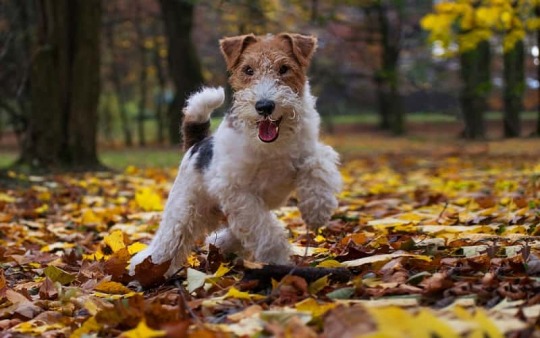
Where it came from and other details Fox Terrier Types of Dogs
The Fox Terrier comes from England in the 18th century, where it was created to help hunters drive foxes out of their dens during fox hunts. Hunters have loved this breed for a long time because it is so good at digging and hunting. Today, they are loved as both active pets and show dogs.
More on the Fox Terrier
They look like small, well-muscled dogs with dark eyes, erect ears, and a wedge-shaped head. Wire Fox Terriers have thick, wiry coats, while Smooth Fox Terriers have smooth, short coats.
They are known for being smart, brave, and curious, and they are always up for an adventure. They have a strong need to hunt and will never stop going after prey.
For many years, this dog was popular as both a family pet and a show dog. They stand out because of how they look and how lively they are.
Temperament: they are playful and spirited, which makes them great pets for active people or families. They love their families and can be very protective of them.
Average life span is 12 to 15 years, but this can vary from person to person depending on genetics and care.
Coat Color: They have different coat colors, such as white with black or tan spots.
Is the Fox Terrier a mixed breed or a unique dog breed? Original dog breeds with pedigrees that can be proven. They are not a mix of breeds.
How to Keep a Fox Terrier Healthy
Food:
Good dog food is important because it gives them the nutrients they need to live an active life.
If you want to help them build muscle, give them a diet full of lean proteins.
Because these dogs can get fat easily, make sure that the portions are kept in check.
The environment:
Do best in places where there is lots of room to run and play.
Keep your yard safe so your pet doesn't get lost, and give your pet toys and puzzles to keep their mind active.
They are great at digging and climbing, so make sure they can't get out of the area.
How to Take Care:
Need to be with you and get attention, so spend quality time with them every day. Keep them happy and mentally stimulated by giving them puzzles and games that they can interact with.
Cleaning up:
Wire Fox Terriers need to have their wiry coats brushed often to keep them in good shape.
Smooth Fox Terriers don't need as much care, but they should still be brushed every so often.
As needed, give your Fox Terrier a bath, and make sure to keep their nails trimmed so they don't grow too long.
How to Get Ready
Three short pieces of advice:
Get ready for a companion who is active and full of energy.
Start socializing them early on to make sure they get along with other dogs.
To get the most out of their intelligence, be patient and consistent with your training.
Taking care:
Give them a healthy diet that is based on how active they are.
Make a place that is safe and interesting.
Getting regular exercise is very important, so be ready to play and go for walks every day.
Put money into puzzles and other mental games to keep their minds active.
To stop them from being so territorial, get them used to other dogs and people.
Important Tools for Caring:
For walks and trips, a strong leash and harness.
Keep their minds active with toys that they can play with.
Grooming tools that are right for their coat type.
Everyday Illnesses:
When the kneecap slips out of place, this is called patellar luxation. Regular visits to the vet can help find and treat this problem.
Hip Dysplasia: To lower your risk of hip dysplasia, eat well and exercise regularly.
Eye Conditions: They may be more likely to get some eye problems, so keep an eye on them and take them to the vet if you need to.
Vaccines that are needed:
Core vaccines: Your friend needs to get rabies, distemper, and parvovirus shots to stay healthy.
Non-core vaccines: Based on your dog's lifestyle and risk factors, talk to your vet to find out if he or she needs any extra vaccines.
Everyday Names
Choosing a Name:
When choosing a name for you, think about one that shows how lively and fun they are. "Max," "Bella," and "Charlie" are all popular names.
Known Names:
Max Bella
Hi, Charlie
Daisy and Rocky
To Lucy Milo
Sophie and Teddy
How to Get or Adopt
Popular places to visit:
In the United States, the United Kingdom, Canada, and Australia, among other places, it is very popular.
Price on average:
The prices vary a lot depending on things like the location, lineage, and reputation of the breeder. You can expect to pay around $1,000 to $2,500 for a well-bred puppy.
Neighborhood for Adoption:
Check out social media sites like Facebook, Twitter, and Instagram to find rescue groups and communities that are all about adoption.
What to Look for Before Buying or Adopting:
General health: Make sure the dog is healthy and doesn't have any problems that you can see.
Status of vaccinations: Make sure the dog has had all the necessary shots for its age.
History of illnesses: Ask the breeder or rescue group for a full history of illnesses.
Groups that help:
Fox Terrier Help in the United States
A group in the UK that helps stray dogs.
Help Save the Canadian Fox Terrier
Finally, these dogs are brave and active, and they have a long history of being hunting partners. They make great pets for active people or families because they can give them the exercise and mental stimulation they need. They need to be socialized and trained properly from a very young age in order to develop friendly and well-balanced personalities.
0 notes
Text
Say Goodbye to Bad Hair Days: Effective Solutions for Common Hair Problems
Having luscious, healthy locks is a dream for many, but unfortunately, various hair problems can get in the way. From hair fall to dryness and damage, these issues can affect our confidence and overall well-being. Fortunately, there are effective treatments and solutions available to address these common hair concerns.

1. Hair Fall Treatment:
Hair fall is a prevalent issue that can be caused by a range of factors, including genetics, stress, and poor nutrition. One effective solution is to use a hair fall treatment such as minoxidil or finasteride, which can promote hair growth and reduce shedding. It's essential to consult with a dermatologist before starting any treatment to determine the best approach for your specific condition.
2. Luxury Hair Treatment:
Pampering your hair with luxury treatments can help restore its vitality and shine. Luxury hair treatments often include high-quality ingredients and advanced techniques to nourish and rejuvenate your locks. These treatments can be found at top hair salons in Perth, like Chilli Couture, known for their premium services.
3. Natural Hair Treatment:
For those who prefer natural solutions, there are plenty of homemade hair treatments using ingredients like coconut oil, aloe vera, and honey. These natural remedies can help moisturize and strengthen your hair, leaving it healthier and more vibrant.
4. Keratin Hair Treatment Perth:
Keratin hair treatments are an excellent choice for those dealing with frizz, unruly curls, or damaged hair. These treatments infuse your hair with keratin protein, making it smoother, shinier, and more manageable. Many salons in Perth offer Keratin treatments to transform your hair.
5. Organic Hair Care Salon in Perth:
If you're looking for a holistic approach to hair care, consider visiting an organic hair care salon in Perth. These salons use natural and organic products free from harsh chemicals to ensure the health and well-being of your hair and scalp.
6. Healthy Hair Treatments:
Maintaining a healthy lifestyle is also essential for promoting strong and beautiful hair. A balanced diet rich in vitamins and minerals, regular exercise, and proper hydration can significantly impact the health of your hair.
In conclusion, common hair problems like hair fall, dryness, and damage can be effectively addressed through various treatments and solutions. Whether you opt for luxury treatment, natural remedies, or organic care, it's essential to choose what works best for your hair type and lifestyle. Visiting top hair salons in Perth, like Chilli Couture, can be a great way to explore these options and find the perfect solution to your hair concerns. Remember that consulting with a professional is crucial for determining the most suitable approach for your specific needs, ensuring that you can enjoy the benefits of healthy and beautiful hair.
Also Read:
1. How to choose the Right Colour for your Skin Tone?
2. How to Choose the Right Curly Haircut for Your Face Shape?
3. Curious About Hair Extensions? Do You Know These 10 Essential Facts?
4. Looking to Enhance Your Hair's Elasticity? Check Out These Top 7 Hair Care Tips!
5. Considering Hair Tinting? Wondering What You Should Know? Dive into This Complete Guide!
Contact:
• Address: - 3/117 Brisbane Street, Perth Western Australia 6000
• Phone No.:- +61452445545
• Location: - https://goo.gl/maps/t4QDUDHjgvn1Q7qx6
• Website: - https://www.chillicouture.com.au/
#organic hair care products#chilli couture#organic hair salon#organic hair salon perth#hair care#organic hair care
0 notes
Text
Mini Australian Shepherd Dog Breeds: Characteristics, Training & 6 Great Care Instructions You Must Know
The Mini Australian Shepherd looks like an Australian Shepherd, but it is smaller. The Mini American Shepherd is another name for this dog.
These very adaptable dogs can do almost everything an Australian Shepherd can do, but because they are small, they can fit into many different kinds of lives.This loyal and loving friend is perfect for people who aren't ready for a bigger dog yet. They will be loyal to any family that can keep up with their high levels of energy for many years.
Getting started
The Miniature Australian Shepherd, also called a "Mini Aussie" in a friendly way, is a cute breed that has won the hearts of dog lovers all over the world. This essay talks about the history, traits, training, care, and place in culture of the Mini Australian Shepherd. It shows how popular it is as a small pet that can go almost anywhere.
The past
The Mini Australian Shepherd is a type of dog that came from the United States. It was made by putting together two smaller Australian Shepherds. At first, these dogs were used to herd animals. They were smart and quick, so they were good at it.
Differences from other Mini Australian Shepherd breeds: Each Mini Australian Shepherd has a different coat color, markings, and eye color. Most of these differences don't come from different breed categories but from differences in genes.
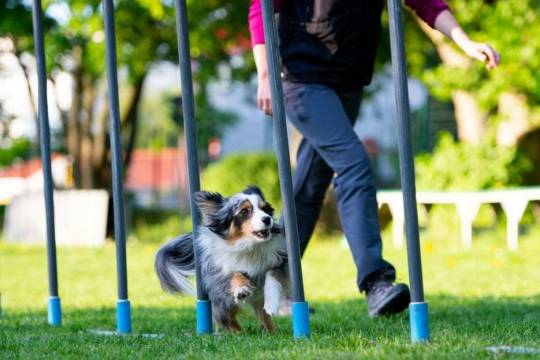
Things that make up
The Mini Australian Shepherd has the same patterns and colors on its coat as the full-sized version. The way they look and the way their eyes are shaped make them look even better.
Characteristics: Mini Aussies are known for being smart and hardworking. They learn quickly and do best when they have to think hard about something.
People often say that Mini Australian Shepherds are friendly, loyal, and loving. They are usually good with kids and other animals and are close to their families.
Size: Mini Aussies are smaller than regular Australian Shepherds, as the name suggests. Most of the time, they are between 33 and 46 cm (13 to 18 inches) tall.
Weight: Most of the time, they are between 9 and 18 kg (20 to 40 pounds).
If they are well taken care of, Mini Australian Shepherds usually live between 12 and 15 years.
Training and getting to know people
The breed needs to be trained and socialized as soon as possible so that its intelligence and energy can be put to good use and it doesn't pick up any bad habits.
Mini Aussies learn well when they get treats, are praised, and have regular training sessions.
Common behavior problems and how to handle them:
The breed is smart and has a lot of energy, so when it's bored, it can sometimes act out. Getting them to do things that use their minds and bodies can help with these issues.
Taking care of things
Common Diseases and Symptoms: Mini Australian Shepherds are usually healthy, but if hip dysplasia or eye problems run in the family, they may be more likely to get them. Going to the vet often is very important.
Dietary needs: For their overall health, they need a diet that is well-balanced and meets all of their nutritional needs.
Mini Aussies are active dogs who need regular exercise to keep their bodies and minds in good shape. Outside, you should play games and do things that get you moving.
Grooming and Hygiene: Their double coat needs to be brushed often to keep it from getting tangled and to keep their skin and coat healthy. As part of grooming, you should also cut your nails, clean your ears, and take care of your teeth.
Reproduction and breeding: Responsible breeding practices focus on the health and well-being of both the parent dogs and the puppies. Breeders who are ethical try to improve the genes of the breed and keep the integrity of the breed.
Where to buy and adopt: It's best to go to reputable breeders who put the welfare of the breed first and follow ethical breeding practices. Another kind thing to do is to get a pet from a shelter or rescue group.
There are small Australian Shepherds in the news.
The Mini Australian Shepherd breed is getting more and more popular, and Mini Aussies have made the news before.
How the Mini Australian Shepherd has been used in movies and on TV:
They are good choices for roles that need dog actors because they look cute and are easy to train.
Mini Australian Shepherds are often shown in the media as smart and devoted pets, which is how they really are.
In the end,
In the end, the Mini Australian Shepherd is a powerful little dog that is smart, loyal, and cute. It used to be a dog for herding, but now it's a much-loved family pet and a versatile partner in different dog sports. The Mini Aussie has a strong work ethic and a sweet personality, which makes it a favorite among dog lovers all over the world.
Mini Australian Shepherds can do well as loved members of families and communities if their unique traits are known, they get the right training, and they get the care they need. This shows how close people and their animals can be.
0 notes
Text
Week 2: A Trip Down River
PROMPT: Describe your ideal role of environmental interpreter. What might it entail? Where might it be? What skills might you need?
As may be slowly becoming evident on this blog, I really like rivers. They are the blood that moves energy and matter over land while providing home, food and transportation to so many living things. Rivers also have amazing historical importance; they have been used for navigation and transportation across large areas, often linking countries and communities to the larger world. Different cultures have had unique ways of either living with or taming rivers that are reflective of their views and practices towards nature. If you ever get the chance to look at old maps of where you live, look for the rivers. Are they in the same place and shape? Do they have the same name as the one you know?
I live on the Grand River and spend as much time as I can in my kayak or canoe. It's a great workout and I have gotten to know my personal stretch of The Grand quite well; the way the two blue herons that always seem to look with expressions disdain and judgment, the beavers who I never see out of the water but evidently work hard as they leave stumps for me to find near the shore, the jumping brown trout who thrive in the cold water of the river that comes up from the bottom of Bellwood Lake. I have become familiar with the favorite spots and behaviors of a lot of the backyard wildlife.
My home on the river has a unique human history as well. It was the site of the first settlement in what is now the town of Fergus. Richard Pierpoint was the founder of this community; he was a black man who was granted the land near the river after serving in the British army. He built a community on the river and if you look over the low lying floodplain you can see rows of old apple trees and piles of stones left by the Pierpoint community. I will to make a post telling Mr. Pierpoints story as best I can in full later on; it deserves its own space and time.
My goal in explaining all this is that I would love to be an interpreter who tells the stories of rivers. I could talk about the geological features of shape and structure that tell us how the river came to flow through a given place in a certain way. I would tell stories of the people who had traveled through an area on boats and point out what animals make their lives around the water and why. I would do this all in my kayak or canoe, with small groups of visitors or with a waterproof video camera to share online. Exercise and nature are two things we all benefit immensely from but often struggle to find time for. I think my dream kayak tours would be a fun way to do both at once with the added bonus of educating people on their local environment; we need water, we should probably try to understand its role in the environment a little better.
I was involved in a lot of improv theater as well as competitive public speaking in high school so I think leaning into that love and experience with storytelling would be a good use of my strengths. Adding historical context and stories is something I have never tried to do in my work as a scientist. Knowing how to research and effectively deliver stories about people and their lives is a necessary skill set for this type of interpretation and I would need to find someone(s) online or offline to learn from.
I like physical recreation and interpretation largely because my learning styles are dominantly auditory followed by kinesthetic, I like to be moving and listening or talking. Any advice from more visual learners as to how to make this set up more engaging to you would be greatly appreciated!
Until next time,
Elle
Note: The first photo is one my friend Jack took of The Grand River a few years ago, the second is one I took a few months ago - it isn't any kind of pollution in the water, the shiny layer you see on the water is from decomposing microbes; it is evidence that groundwater is seeping up through the limestone!


1 note
·
View note